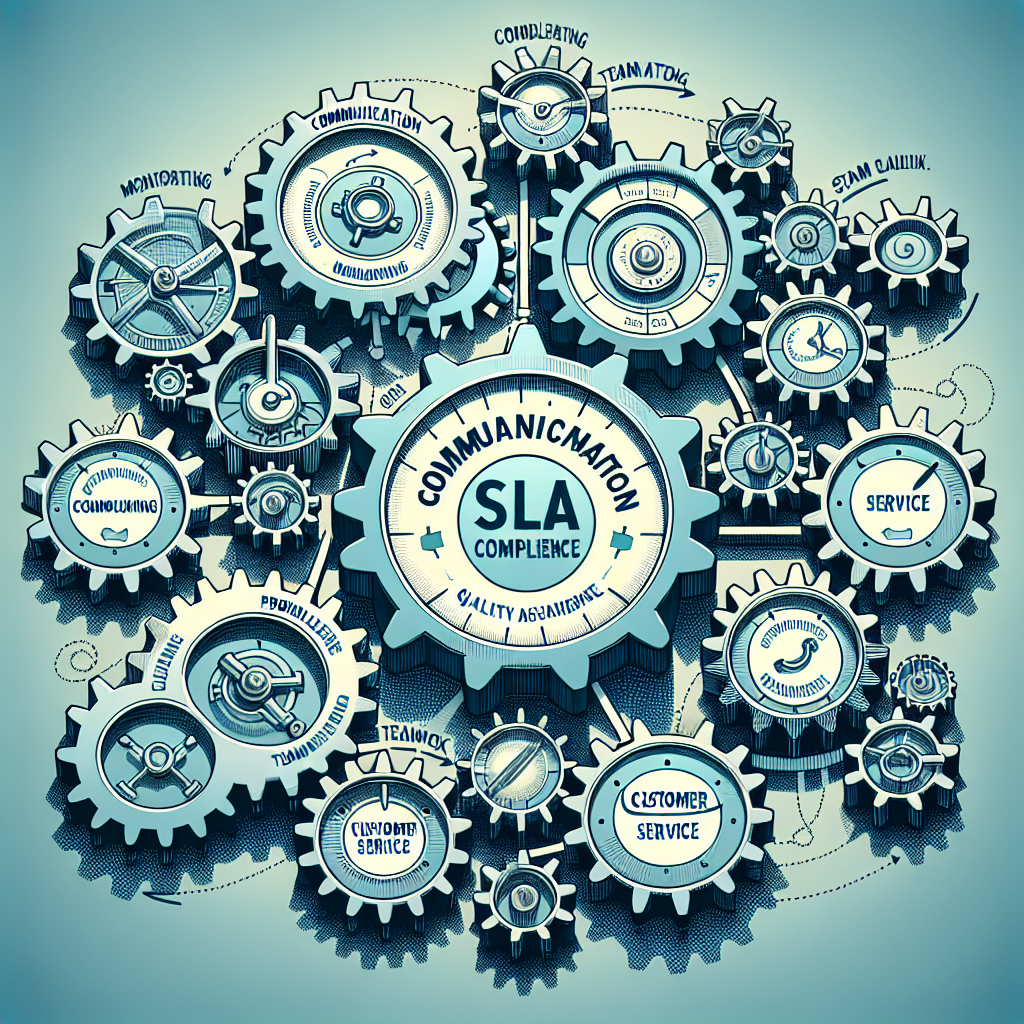Your cart is currently empty!
Tag: SLAs

The Future of Service Level Agreements (SLAs) in a Digital Age
In today’s fast-paced digital age, businesses are increasingly relying on technology to streamline their processes and improve efficiency. As a result, Service Level Agreements (SLAs) are becoming more important than ever before.SLAs are contracts between a service provider and a customer that outline the level of service that is expected to be delivered. They typically include metrics such as response times, uptime guarantees, and resolution times for issues. In the past, SLAs were primarily used for traditional services like IT support or telecommunications. However, in the digital age, SLAs are being applied to a wide range of services, from cloud computing to social media management.
One of the key challenges facing businesses in the digital age is the need to constantly adapt to changing technology and customer expectations. This means that traditional SLAs, which may have been sufficient in the past, may no longer be adequate. As a result, businesses are now looking for more flexible and dynamic SLAs that can be easily updated as technology evolves.
One way that businesses are addressing this challenge is by implementing real-time monitoring and reporting tools that allow them to track performance metrics and adjust SLAs accordingly. This enables businesses to quickly identify and address any issues that may arise, ensuring that they can meet their service level commitments.
Another trend that is shaping the future of SLAs in the digital age is the increasing use of automation and artificial intelligence. These technologies have the potential to revolutionize the way that services are delivered, making it possible to provide faster, more efficient, and more personalized service. As a result, businesses are looking to incorporate these technologies into their SLAs in order to improve their service offerings and meet the changing needs of their customers.
Overall, the future of SLAs in the digital age is one of increased flexibility, adaptability, and innovation. Businesses that are able to embrace these changes and implement dynamic, technology-driven SLAs will be better positioned to succeed in an increasingly competitive and fast-paced business environment.

Best Practices for Managing and Enforcing Service Level Agreements (SLAs)
Service Level Agreements (SLAs) are a crucial component of any business relationship between a service provider and their clients. SLAs outline the level of service that can be expected, as well as the consequences if those expectations are not met. However, managing and enforcing SLAs can be a complex and challenging task. In this article, we will explore some best practices for effectively managing and enforcing SLAs.1. Clear and Specific SLAs: The first step in effectively managing and enforcing SLAs is to ensure that they are clear, specific, and measurable. SLAs should clearly outline the services that will be provided, the expected performance levels, and any penalties for failure to meet those levels. Ambiguity in SLAs can lead to misunderstandings and disputes, so it is crucial to be as specific as possible.
2. Regular Monitoring and Reporting: Once SLAs are in place, it is important to regularly monitor performance levels and provide detailed reports to both the service provider and the client. This allows both parties to track progress, identify any areas of concern, and take corrective action if necessary. Regular monitoring also helps to build trust and transparency in the business relationship.
3. Open Communication: Effective communication is key to successfully managing and enforcing SLAs. Both parties should have open lines of communication to discuss any issues or concerns that may arise. Regular meetings and updates can help to ensure that both parties are on the same page and working towards the same goals.
4. Proactive Issue Resolution: Inevitably, there will be times when SLAs are not met. When issues arise, it is important to take a proactive approach to resolving them. Rather than waiting for the client to raise a concern, the service provider should be proactive in addressing any issues and finding solutions to prevent them from happening again in the future.
5. Flexibility and Adaptability: Business environments are constantly evolving, so it is important for SLAs to be flexible and adaptable to changing circumstances. Both parties should be willing to revisit and revise SLAs as needed to ensure that they remain relevant and effective.
6. Escalation Process: In the event that SLAs are consistently not met, it is important to have a clear escalation process in place. This process should outline the steps that will be taken if performance levels do not improve, including potential penalties or termination of the agreement.
In conclusion, managing and enforcing SLAs requires a combination of clear communication, regular monitoring, proactive issue resolution, and a willingness to adapt to changing circumstances. By following these best practices, businesses can ensure that their SLAs are effectively managed and enforced, leading to stronger and more successful business relationships.

The Role of Service Level Agreements (SLAs) in Outsourcing and Vendor Management
Outsourcing has become a common business strategy in today’s global economy. Companies are increasingly turning to third-party vendors to handle various aspects of their operations, from IT services to customer support. However, managing these vendor relationships can be challenging, as it involves dealing with different service providers, each with their own set of expectations and deliverables.This is where Service Level Agreements (SLAs) come into play. An SLA is a contract between a service provider and a client that outlines the level of service that is expected, as well as the consequences for failing to meet those expectations. SLAs are essential in outsourcing and vendor management because they help to ensure that both parties are on the same page regarding service levels, responsibilities, and expectations.
One of the key roles of SLAs in outsourcing is to establish clear and measurable metrics for performance. By defining specific key performance indicators (KPIs) in the SLA, both the client and the vendor know exactly what is expected in terms of service quality, response times, and overall performance. This helps to minimize misunderstandings and ensures that the vendor is held accountable for meeting the agreed-upon standards.
SLAs also play a crucial role in managing risk in outsourcing relationships. By clearly outlining the responsibilities of both parties, SLAs help to mitigate the potential for disputes and disagreements. If a vendor fails to meet the agreed-upon service levels, the SLA typically includes provisions for remediation, such as financial penalties or termination of the contract. This incentivizes vendors to consistently deliver high-quality services and provides clients with recourse in case of any issues.
Furthermore, SLAs can help to improve communication and collaboration between the client and the vendor. By setting clear expectations from the outset, SLAs help to establish a framework for regular communication and feedback. This can lead to more productive and efficient working relationships, as both parties are aligned on their goals and objectives.
In conclusion, Service Level Agreements play a critical role in outsourcing and vendor management. By defining clear expectations, establishing measurable metrics for performance, and managing risk, SLAs help to ensure successful and mutually beneficial relationships between clients and vendors. Companies that effectively leverage SLAs in their outsourcing initiatives are more likely to achieve their business objectives and drive long-term success.

How Service Level Agreements (SLAs) Drive Customer Satisfaction and Loyalty
Service Level Agreements (SLAs) are a vital component of any business relationship, as they outline the expectations and responsibilities of both parties. In the realm of customer service, SLAs play a significant role in driving customer satisfaction and loyalty.SLAs are essentially a contract between a service provider and a customer, specifying the level of service that will be provided, including response times, resolution times, and performance metrics. By setting clear expectations and establishing accountability, SLAs help to ensure that customers receive the service they expect and deserve.
One of the key ways in which SLAs drive customer satisfaction is by providing transparency and clarity. When customers know exactly what to expect in terms of response times and resolution times, they are more likely to feel confident in the service provider’s ability to meet their needs. This helps to build trust and credibility, which are essential elements of a strong customer-provider relationship.
Additionally, SLAs help to ensure consistency and reliability in service delivery. By establishing clear benchmarks and performance metrics, service providers can monitor their performance and make improvements where necessary. This helps to prevent service disruptions and delays, which can lead to customer dissatisfaction and frustration.
Furthermore, SLAs can also serve as a measure of accountability. If a service provider fails to meet the terms of the SLA, the customer may be entitled to compensation or other remedies. This incentivizes service providers to prioritize customer satisfaction and strive to meet or exceed the terms of the agreement.
Ultimately, by aligning customer expectations with service provider capabilities, SLAs help to enhance the overall customer experience. When customers receive the level of service they expect and deserve, they are more likely to be satisfied with their experience and develop a sense of loyalty towards the service provider. This can lead to repeat business, positive word-of-mouth recommendations, and long-term customer relationships.
In conclusion, Service Level Agreements are a powerful tool for driving customer satisfaction and loyalty. By setting clear expectations, ensuring consistency and reliability, and providing accountability, SLAs help to foster strong customer-provider relationships and ultimately, drive business success. Businesses that prioritize SLAs as a key component of their customer service strategy are more likely to achieve high levels of customer satisfaction and loyalty in the long run.

The Benefits of Implementing Service Level Agreements (SLAs) in Your Business
In today’s competitive business landscape, it is essential for companies to prioritize customer satisfaction and ensure that they are meeting their clients’ needs and expectations. One effective way to achieve this is by implementing Service Level Agreements (SLAs) in your business.A Service Level Agreement is a contract between a service provider and a customer that outlines the level of service that is expected to be delivered. This agreement sets clear expectations for both parties and helps to ensure that the service provider is meeting the customer’s requirements.
There are several benefits to implementing SLAs in your business:
1. Improved customer satisfaction: By clearly outlining the level of service that will be provided, SLAs help to manage customer expectations and ensure that they are receiving the service they require. This leads to higher levels of customer satisfaction and loyalty.
2. Increased accountability: SLAs hold service providers accountable for meeting the agreed-upon service levels. This helps to ensure that the service provider is delivering on their promises and meeting the needs of their customers.
3. Enhanced communication: SLAs provide a clear framework for communication between the service provider and the customer. This helps to ensure that both parties are on the same page and can easily address any issues that may arise.
4. Improved efficiency: With SLAs in place, service providers are able to prioritize their resources and focus on delivering the services that are most important to their customers. This leads to increased efficiency and better overall performance.
5. Competitive advantage: By implementing SLAs, businesses can differentiate themselves from their competitors and demonstrate their commitment to providing high-quality service. This can help to attract new customers and retain existing ones.
Overall, implementing Service Level Agreements in your business can have a positive impact on customer satisfaction, accountability, communication, efficiency, and competitive advantage. By clearly outlining the level of service that will be provided and holding service providers accountable for meeting these standards, businesses can ensure that they are meeting their customers’ needs and expectations.

Ensuring Compliance with Service Level Agreements (SLAs): Strategies for Success
Service Level Agreements (SLAs) are a crucial component of any business relationship, providing a clear set of expectations and standards for service delivery. However, ensuring compliance with SLAs can be a challenging task, requiring careful planning and strategic implementation. In this article, we will discuss some key strategies for success in meeting SLA requirements and maintaining strong relationships with clients.1. Clear Communication: The first step in ensuring compliance with SLAs is to establish clear lines of communication with clients. This includes setting expectations from the outset, discussing any potential challenges or limitations, and regularly updating clients on progress towards meeting SLA requirements. By maintaining open and transparent communication, you can build trust with clients and avoid misunderstandings that could lead to SLA breaches.
2. Performance Monitoring: Monitoring performance is essential for meeting SLA requirements and identifying potential issues before they escalate. Implementing key performance indicators (KPIs) and regular performance reviews can help you track progress, identify areas for improvement, and make adjustments as needed to ensure compliance with SLAs. By staying proactive in monitoring performance, you can address any issues promptly and maintain a high level of service quality.
3. Resource Allocation: Adequate resource allocation is crucial for meeting SLA requirements and delivering on client expectations. This includes ensuring that you have the right people, technology, and processes in place to meet SLA commitments. By carefully allocating resources based on SLA requirements and client needs, you can avoid bottlenecks, delays, and other issues that could impact compliance with SLAs.
4. Continuous Improvement: Continuous improvement is key to ensuring compliance with SLAs and maintaining a high level of service quality. By regularly reviewing and analyzing performance data, soliciting feedback from clients, and implementing process improvements, you can identify opportunities for optimization and enhance your ability to meet SLA requirements. By committing to continuous improvement, you can adapt to changing client needs and market conditions, and ensure long-term success in meeting SLA commitments.
5. Contract Management: Effective contract management is essential for ensuring compliance with SLAs and mitigating risks associated with service delivery. This includes clearly defining roles and responsibilities, setting realistic expectations, and establishing mechanisms for resolving disputes or addressing SLA breaches. By managing contracts effectively and proactively addressing any issues that arise, you can protect your business interests and maintain strong relationships with clients.
In conclusion, ensuring compliance with SLAs requires a combination of clear communication, performance monitoring, resource allocation, continuous improvement, and effective contract management. By implementing these key strategies for success, you can meet SLA requirements, exceed client expectations, and build strong, long-lasting relationships with clients.

Negotiating Service Level Agreements (SLAs) with Vendors: Best Practices and Tips
Service Level Agreements (SLAs) are a crucial component of any business contract with a vendor. These agreements outline the level of service that the vendor will provide, including response times, uptime guarantees, and other key performance indicators. Negotiating SLAs with vendors can be a complex process, but with the right approach and best practices, you can ensure that you are getting the level of service that your business needs.One of the first steps in negotiating SLAs with vendors is to clearly define your requirements and expectations. This includes identifying the key performance indicators that are most important to your business, such as response times, uptime guarantees, and service availability. By clearly outlining your needs, you can ensure that the vendor understands what is expected of them and can tailor their service offerings accordingly.
When negotiating SLAs with vendors, it is important to be realistic and reasonable in your expectations. While it is important to push for the best possible service levels, it is also important to consider the vendor’s capabilities and limitations. By being flexible and open to compromise, you can ensure that the final SLA is fair and achievable for both parties.
Another best practice when negotiating SLAs with vendors is to include specific metrics and measurement processes in the agreement. This allows both parties to track performance against the agreed-upon standards and provides a basis for evaluating the vendor’s performance. By including these metrics in the SLA, you can hold the vendor accountable for meeting their obligations and ensure that you are getting the level of service that you are paying for.
It is also important to establish clear communication channels and escalation procedures in the SLA. This ensures that any issues or disputes can be quickly addressed and resolved, minimizing the impact on your business operations. By outlining these processes in the agreement, you can ensure that both parties are on the same page and can work together effectively to resolve any issues that may arise.
In addition to these best practices, there are a few key tips to keep in mind when negotiating SLAs with vendors. First, be sure to thoroughly review and understand the terms of the agreement before signing. This includes reviewing all service level commitments, penalties for non-compliance, and dispute resolution processes. By fully understanding the terms of the agreement, you can avoid any surprises or misunderstandings down the line.
Second, be sure to negotiate a fair and reasonable pricing structure for the services outlined in the SLA. This includes not only the base price for the services, but also any additional fees or charges that may apply. By negotiating a transparent and fair pricing structure, you can ensure that you are getting the best value for your investment and avoid any unexpected costs.
Overall, negotiating SLAs with vendors requires careful planning, clear communication, and a willingness to compromise. By following these best practices and tips, you can ensure that you are getting the level of service that your business needs while also building a strong and mutually beneficial relationship with your vendor.

The Role of Service Level Agreements (SLAs) in Improving Customer Satisfaction
Service Level Agreements (SLAs) are crucial documents that outline the expectations and responsibilities between a service provider and a customer. These agreements define the level of service that will be provided, including response times, resolution times, and performance metrics. By setting clear guidelines and expectations, SLAs play a key role in improving customer satisfaction.One of the main benefits of SLAs is that they help to establish trust and transparency between the service provider and the customer. By clearly outlining the services that will be provided and the level of support that can be expected, SLAs help to manage customer expectations from the outset. This can help to prevent misunderstandings and disputes down the line, leading to a more positive customer experience.
SLAs also help to ensure that service providers are held accountable for meeting their commitments. By specifying performance metrics and targets, SLAs provide a benchmark against which the service provider’s performance can be measured. This can help to identify any areas where the service provider is falling short and take corrective action to improve service delivery.
Furthermore, SLAs can help to improve communication and collaboration between the service provider and the customer. By clearly defining roles and responsibilities, SLAs help to establish a common understanding of what is expected from both parties. This can help to streamline communication, reduce misunderstandings, and ensure that issues are addressed in a timely and efficient manner.
In addition, SLAs can help to drive continuous improvement in service delivery. By monitoring performance against the targets set out in the SLA, service providers can identify areas for improvement and take proactive steps to enhance their services. This can lead to better service quality, increased efficiency, and ultimately, higher levels of customer satisfaction.
In conclusion, Service Level Agreements play a crucial role in improving customer satisfaction by setting clear expectations, establishing trust and transparency, holding service providers accountable, improving communication and collaboration, and driving continuous improvement in service delivery. By implementing SLAs, businesses can enhance their customer relationships, build loyalty, and ultimately, drive business success.

Measuring Success: Monitoring and Reporting on Service Level Agreements (SLAs)
Service Level Agreements (SLAs) are crucial agreements between a service provider and a customer that outline the level of service that will be provided. Monitoring and reporting on SLAs is essential to ensure that both parties are meeting their obligations and achieving the desired outcomes.Measuring success in meeting SLAs involves tracking key performance indicators (KPIs) to assess the quality and efficiency of the services being provided. These KPIs can include metrics such as response times, resolution times, uptime, and customer satisfaction ratings. By monitoring these metrics regularly, service providers can identify areas for improvement and take corrective actions to ensure that SLAs are being met.
In addition to monitoring KPIs, reporting on SLAs is also important for providing transparency and accountability. Regular reporting allows both the service provider and the customer to track progress, identify any issues or challenges, and make informed decisions about how to improve service delivery.
Effective reporting on SLAs should be clear, concise, and relevant to the goals and objectives outlined in the agreement. Reports should provide a summary of performance against agreed-upon targets, highlight any deviations or shortcomings, and include recommendations for improvement.
To ensure successful monitoring and reporting on SLAs, it is important for both parties to have clear communication and collaboration. Service providers should be proactive in sharing performance data with customers, seeking feedback, and discussing any challenges or concerns. Customers, on the other hand, should provide timely feedback, communicate any changes or updates to their requirements, and work with the service provider to address any issues that may arise.
Ultimately, monitoring and reporting on SLAs is a critical aspect of ensuring the success of service delivery and maintaining a positive and productive relationship between service providers and customers. By tracking performance metrics, identifying areas for improvement, and communicating openly and effectively, both parties can work together to achieve their mutual goals and objectives.

The Role of SLAs in Managing Vendor Relationships
In today’s fast-paced business environment, organizations are increasingly relying on external vendors to provide goods and services that are critical to their operations. While outsourcing can bring significant benefits in terms of cost savings and access to specialized expertise, it also introduces a level of risk. This is where Service Level Agreements (SLAs) come into play.SLAs are formal contracts that define the expectations and responsibilities of both parties in a vendor-client relationship. They outline the specific services to be provided, the quality standards that must be met, and the consequences for failing to meet these standards. By clearly defining these parameters, SLAs help to establish a framework for effective communication, accountability, and performance monitoring.
One of the key roles of SLAs in managing vendor relationships is to align the interests of both parties. By establishing clear expectations and objectives, SLAs can help to ensure that the vendor’s goals are in line with those of the client. This can help to prevent misunderstandings and conflicts that can arise when there is ambiguity about roles and responsibilities.
SLAs also play a crucial role in managing vendor performance. By setting measurable performance metrics and service levels, SLAs provide a basis for monitoring and evaluating the vendor’s performance. This allows the client to hold the vendor accountable for meeting agreed-upon standards and to take corrective action if necessary. In this way, SLAs help to ensure that the vendor delivers the quality of service that is required to support the client’s business objectives.
Another important role of SLAs is to provide a mechanism for resolving disputes and conflicts. By clearly defining the terms of the agreement, including procedures for escalating issues and resolving disputes, SLAs help to facilitate effective communication and problem-solving between the client and the vendor. This can help to prevent misunderstandings from escalating into more serious conflicts that can disrupt the relationship and undermine the success of the outsourcing arrangement.
In conclusion, SLAs play a critical role in managing vendor relationships by establishing clear expectations, aligning interests, monitoring performance, and resolving disputes. By providing a structured framework for communication and accountability, SLAs help to ensure that the vendor-client relationship is productive, efficient, and mutually beneficial. Organizations that effectively utilize SLAs in their vendor management practices are better positioned to maximize the benefits of outsourcing while minimizing the risks.
